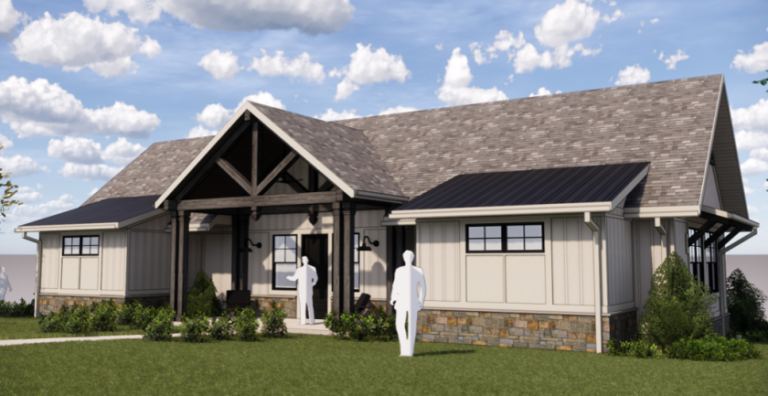ALTO, New Mexico (July 20, 2017) — There is a whole lot to like about South Central New Mexico and especially the Ruidoso Valley, which consists of, among others, the Lincoln County towns of Ruidoso Downs, Ruidoso and Alto.
After all, this area has been the playground of Texans, Louisianans and Oklahomans for years, thanks to its combination of cool weather in the hotter months, ski opportunities in the fall, winter and spring and the draw of mountain living and play.
Here, the Sacramento Mountains rise majestically above the surrounding desert plains and a landscape dominated by a snow-capped peak, Sierra Blanca, which peaks at an altitude of more than 12,000 feet. This is a magical valley where tall pines whisper in the breeze, a rushing stream makes lively music, and silence and isolation are your neighbors and welcome friends.
Golf is a big part of the draw here as well and if there’s one course that must be played when in the area it’s the Golf Club at Rainmakers in Alto, just north of Ruidoso.
Since 2008, the Golf Club at Rainmakers has become one of the most desired places to play in this part of New Mexico. The course rests within a golf and recreational community involving more than 1,000 acres adjacent to Lincoln County’s renowned Spencer Theater for the Performing Arts, which presents touring Broadway shows, concerts and dance performances.
The entire community and the golf course designed by Robert Trent Jones II are members of the Audubon International Signature Program, and, accordingly, no effort has been spared to protect the native flora and fauna, to conserve and manage the water resources, and build only the most energy-efficient homes.
Renowned for environmental stewardship, Rainmakers is on the cutting edge of water conservation, using polymers to cool grass temperatures by as much as 12 degrees. Those polymers conserve up to 30 percent of typical water consumption on the 1,023-acre development.
The heart of Rainmakers is Jones’ 7,101-yard, par-72 track, which opened for play in July 2008.
“At Rainmakers, the land spoke with two distinct voices,” Jones said. “The amazing scenery called out with distant views of layered juniper and pine-covered hills transitioning to snow-capped mountains, while the golf course site itself whispered softly with the rugged accent of the American desert.”
Both voices harmonize in the final design, but don’t get caught up in the scenery and ambiance of pristine nature. This is a golf course that demands your attention from first swing to final putt, and anything less will leave you frustrated and wanting.
The test begins at the starting hole, a par-5 that plays to a whopping 691 yards from the back tees. There is no downhill shot here, but the hole (which took a driver, a 3-metal and 7-medal from 195 yards to reach the green) was designed to take advantage of a prevailing wind at your back.
You get a little bit of help on the second hole, which is another par-5 but is much more manageable at 515 yards. “No. 2 was originally a par-4, but we decided that – after the first hole – most players would like some redemption,” said Jones. “Maybe they can make a birdie on No. 2.”
Other memorable holes are the 224-yard, downhill par-3 third, which drops 80 feet from tee to green; the sixth, which is bordered on its left and in green front by a ball-eating 40-foot deep arroyo and the 10th, a short (374-yard) par-4 that goes down then up and banks sharply from right to left toward the aforementioned and deadly arroyo.
Then there’s the 186-yard, par-3 11th, whose front-right pin placement makes you flirt with the dry creek bed that runs alongside the green; the 203-yard, par-3 15th, which asks for a full carry over the lake that defines the hole and fronts the green; and the reachable 538-yard, par-5 C-shaped finishing hole, a left to right gem that requires two shots over a canyon. There are three par-5s on the front side, which plays to a par of 37. The back side sports three par-3s and all are a challenge.
Jones said he is most proud of the 142-yard 17th, which he described as an island green without the water. The elevated tee box drops severely into a valley green with little room for errant shots. Hit long or right, and the golf ball is lost into a canyon. Hit left and the ball will roll for yards down a hill. Even if it’s safe, the pitch will likely be a blind shot up toward the green.
More than anything, what distinguishes the Rainmakers golf course the most is the beauty and diversity of its terrain – meadows of native grasses, Ponderosa, pinon and juniper pines, natural arroyos, dramatic rock outcroppings and a view of Sierra Blanca or the Capitan mountains from 12 holes.
Golfers are drawn to the challenge of this wonderful track and heartily remember specific holes and how they played them. That makes them want to come back and play it again – and that’s what great golf courses are supposed to do.
Rainmakers is a track that wears you out, even on a relatively benign and sunny day when the wind was not whipping through the mountain pass. Our advice is to play Rainmakers as much as you can, but be prepared to swallow your pride and lose more than a few golf balls on your journey around Jones’ beautiful and relentless course.











